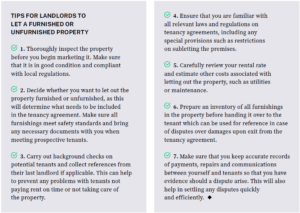Contact
020 4515 6728
info@ccameron.co.uk
Charles Cameron & Associates
Blackfriars Foundry
154-156 Blackfriars Road
London SE1 8EN
Letting furnished or unfurnished?
February 25, 2023
Information published was correct at the time of writing
Ultimately, you should weigh up both options carefully

When considering whether to let a furnished or unfurnished property, landlords should take several factors into account. There is no right or wrong answer and the type of property and location often determine whether it’s best to provide furnishings or not. Furnished properties are attractive to tenants who may only need short-term accommodation and do not want the hassle of buying furniture. An unfurnished property is usually also less attractive to younger tenants and those on low incomes who may not have the funds for furniture upfront.
WEIGH UP BOTH OPTIONS CAREFULLY
Furthermore, if you wish to obtain a higher rental income then a well-furnished property will often command a higher rent due to the added convenience and comfort it offers. Ultimately, you should weigh up both options carefully. Typically, apartments let on behalf of landlords are furnished, but less so with houses. This is mainly due to the tenant demand; apartments are often rented by young professionals who don’t own furniture and are looking for a modern home, whereas larger homes are rented by families who have accumulated their own furniture over the years and prefer to put their own mark on the property.
COMPLY WITH RELEVANT REGULATIONS
You should ensure that you comply with relevant regulations regarding the condition of any furniture supplied or the safety of any electrical items provided in a furnished property. This will help to ensure that professional standards are maintained throughout the tenancy management process and that tenants feel comfortable and safe in the accommodation being offered. This is key in order to ensure the best outcome for landlords and tenants alike. Regardless of the option chosen, landlords must ensure that they have a clear and comprehensive agreement in place with their tenants detailing exactly what is included in either a furnished or unfurnished property. This will help to avoid any misunderstandings further down the line and protect both the tenant’s rights and your own interests as a professional landlord. By taking these steps, landlords can be sure that their rental property remains profitable for many years to come.
MAXIMISE RETURNS ON INVESTMENT
By considering all of these factors, landlords can be sure to make the right choice when deciding whether to let a furnished or unfurnished property, and ensure that their rental units remain in high demand. Taking this approach will help landlords to maximise returns on investment and provide a secure and comfortable home for tenants. Regardless of which option you choose, professional landlords should always adhere to professional standards in order to protect both their own interests and those of their tenants.

Don’t forget, our professional, friendly advisers are on hand to support you and can help you explore all of your options.



